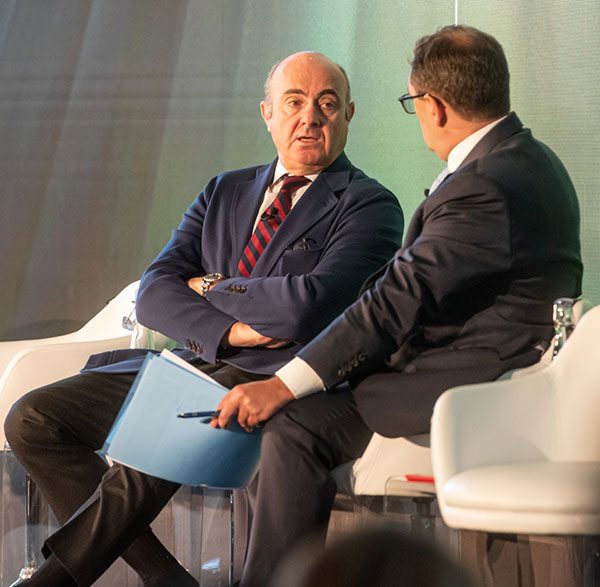The structural challenges facing the Eurozone are stark as the region grapples with desultory economic growth and persistently low interest rates. At BNP Paribas Global Markets’ flagship conference in November, Luis de Guindos, vice president at the European Central Bank (ECB), was interviewed by Luigi Speranza, Chief global economist for Global Markets. He shared his unique insights into the Eurozone’s current fragilities along with some of the remedies that could potentially offset further stagnation, here are six crucial takeaways set to define the outlook for the Eurozone.
The Eurozone is poised to avoid a recession
Even though Eurozone economic growth continues to be precarious – increasing by just 0.2% in Q2 of 2019 – owing to a slowdown in Germany, Brexit and ongoing trade conflicts, de Guindos is confident a recession will be avoided, noting, “the most recent data points illustrate the euro-area will stabilise as will the global economy.” He also conceded the Eurozone was at risk of facing a long period of growth rates below its potential, although he doubted the region would suffer from Japanification, a term coined by economists to describe the country’s 30 year + battle with deflation and insipid growth. Explaining his optimism, de Guindos said the euro-area was blessed with more favorable demographics; stronger banks and greater fiscal manoeuvring room than Japan had been.

Inflation going on a potential upward trajectory
Irrespective of the recent increase in wages, the Eurozone’s core inflation rate continues to hover at 1%, and has done so for more than two years now, which is well below the ECB’s 2% target. De Guindos said this ongoing low inflation was a direct consequence of the weak economic growth that has plagued the Eurozone over the last decade. Moreover, he said a number of companies are hesitant about ratcheting up their prices in case it causes them to lose market share. Despite this, de Guindos said inflation would likely increase as wages in Western Europe are predicted to rise. He even warned heightened labour costs could – in extremis – cause an inflationary shock, and cautioned against complacency.
Can the Eurozone be fixed?
It is clear the Eurozone is facing a number of existential problems, although de Guindos was at pains to stress that Central Banks did not have all of the answers. He said policymakers and other market participants had an equally important role to play in driving and delivering on reforms. He cited the example of Spain, whose recovery from the sovereign debt crisis, has been nothing short of exceptional. The revitalisation of the Spanish economy – which is now one of the best performing in Europe – was made possible by market liberalisation, competitive tax reforms and massive restructuring of the country’s domestic banks, he acknowledged. “The lesson to be drawn from Spain is that reforms do pay,” said de Guindos.
The side-effects of low interest rates on banks
In response to the latest slowdown, the ECB hopes its most recent decision to cut interest rates even further into negative territory will help stimulate a recovery across the Eurozone. Nonetheless, de Guindos is acutely aware that negative rates are having an adverse impact on the profitability at Eurozone banks, as institutions struggle to generate income off interest bearing assets. Low bank profitability, he said, is the biggest systemic risk presently facing the Eurozone.
The most recent data points illustrate the euro-area will stabilise as will the global economy.
While low rates have been destabilising, de Guindos said structural deficiencies within the European banking industry, such as a lack of consolidation, excess capacity and high cost-income ratios, were also having a detrimental effect on revenues.
EU officials have repeatedly stated that a common banking union will be pivotal to preserving the Eurozone’s financial stability, especially if it helps promote M&A and wider consolidation across the financial services industry. The banking union premise is not without its challenges however. De Guindos said that while the EU had harmonised rules around bank resolution planning, there were major obstacles facing the banking union, not least the absence of a pan-EU deposit insurance scheme. However, the German finance ministry’s announcement that it was no longer opposed to a common EU scheme to protect depositors during bank failures was a step in the right direction, according to de Guindos.

Well on the path to a safer banking model
De Guindos said the banking industry had made some notable improvements to its operating model. Most significantly, he said Eurozone banks were now more resilient to crises as they hold larger quantities of regulatory (i.e. high quality) capital; maintain robust liquidity buffers and have more stable funding sources, all of which were phased in as part of Basel III. He also pointed out that toxic assets such as non-performing loans (NPLs) – which had once threatened the solvency of some institutions – were being wound down.
Even though Eurozone banks have made enormous strides through deleveraging and by strengthening their balance sheet capital strength, de Guindos said improvements were still necessary. In particular, he highlighted CCyBs (countercyclical capital buffers) – which are designed to counteract pro-cyclicality in the financial system and comprise mostly of Common Equity Tier 1 capital – account for only a fraction of the capital positions at Eurozone banks. De Guindos outlined that CCyBs would be instrumental in helping Eurozone financial institutions navigate downturns, and advised banks to build up their CCyB reserves.
Central Banks promote Sustainability
Having accepted that climate change risk has systemic implications, more Central Banks – including the ECB – are paying greater attention to it. De Guindos confirmed the ECB was focusing more on climate change from a market stability perspective, assessing the macroprudential impact of physical disasters and widespread transitioning (i.e. moving from brown to green) by major companies and banks. He added discussions about integrating climate change risks into bank stress tests were underway at the ECB-level too. De Guindos also said the European Commission was being very proactive on ESG and is currently drafting a taxonomy for sustainability that will be made available to institutional investors.

BNP Paribas’ Global Markets conference, now in its fourth year, brings together leaders from the worlds of geo-politics, economics, investment and finance to tackle the crucial issues facing the industry today. The conference has fast become known as the finance industry’s ‘must-see’ client event, attracting over 450 key corporate and institutional clients of the bank this year.